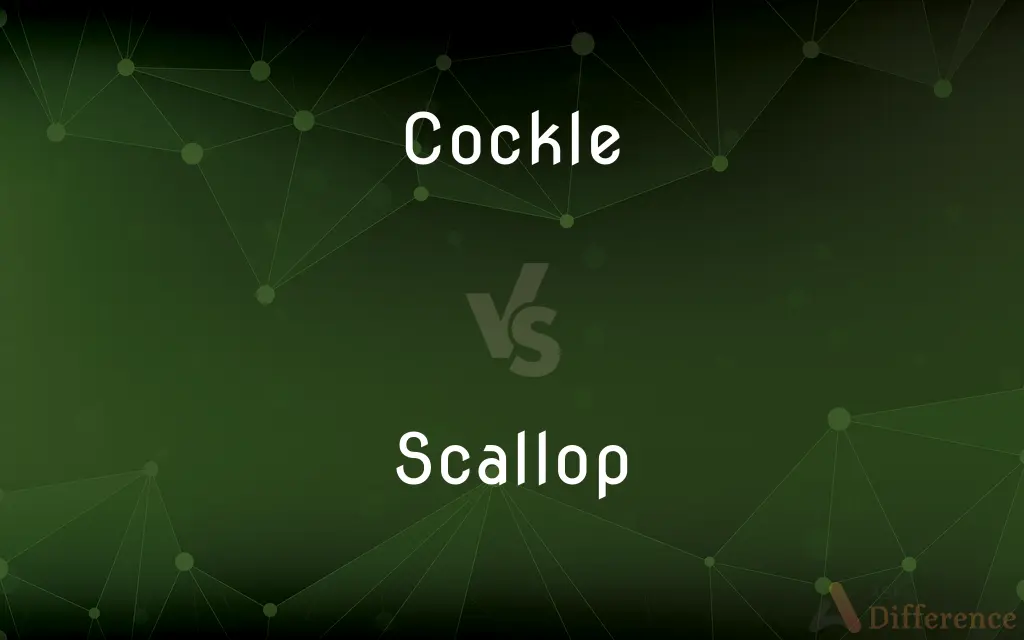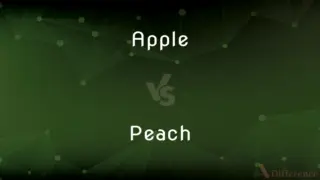Cockle vs. Scallop — What's the Difference?
By Fiza Rafique & Maham Liaqat — Updated on March 22, 2024
Cockles are small, edible, marine bivalves, known for their distinctive ribbed shells, while scallops are larger bivalves with fan-shaped shells, famous for their sweet, tender meat.

Difference Between Cockle and Scallop
Table of Contents
ADVERTISEMENT
Key Differences
Cockles are a type of small, edible marine bivalve mollusk, often found in sandy, shallow coastal waters around the world. They have a distinctive appearance, characterized by their rounded, ribbed shells which are usually symmetrical. Scallops, on the other hand, are larger bivalves with a more varied habitat, ranging from shallow coastal areas to deep sea waters. Their shells are fan-shaped and can exhibit a range of colors, with one flat side and one convex side, reflecting their different lifestyle.
While cockles burrow into sandy or muddy bottoms, using their foot to dig, scallops have the unique ability among bivalves to swim through the water by rapidly opening and closing their shells. This not only helps them escape predators but also aids in their distribution across various depths and areas.
Both cockles and scallops are highly valued for their meat. Cockle meat is known for its rich flavor and firm texture, making it a popular choice for seafood dishes, soups, and stews. Scallop meat, particularly from the adductor muscle that they use to open and close their shell, is prized for its sweet, delicate flavor and tender texture, often served seared, grilled, or raw in sashimi.
In terms of ecological impact and fisheries, cockles are often harvested by hand or with rakes, leading to less environmental disruption. Scallop fisheries, however, can involve dredging, which has a greater environmental impact due to habitat disturbance. Sustainable fishing practices are critical for both species to prevent overharvesting and ensure their populations remain healthy.
Despite their differences, both cockles and scallops play important roles in their ecosystems as filter feeders, cleaning the water by removing particles. Their presence indicates the health of their respective habitats, with declines often signaling environmental issues.
ADVERTISEMENT
Comparison Chart
Shell Shape
Rounded, ribbed shells.
Fan-shaped, often colorful shells.
Size
Generally smaller.
Larger, with a meatier body.
Habitat
Sandy or muddy bottoms in shallow waters.
Varied, from shallow coasts to deep sea waters.
Locomotion
Burrow into the substrate.
Can swim by opening and closing shells.
Culinary Use
Used in soups, stews, and seafood dishes.
Prized for searing, grilling, or as sashimi.
Fishing Impact
Often harvested by hand, less environmental impact.
Dredging can disturb habitats, higher environmental impact.
Compare with Definitions
Cockle
A small, edible bivalve mollusk with a distinctive rounded, ribbed shell.
The cockles were gathered at low tide along the sandy shore.
Scallop
Fishing methods like dredging can be harmful.
Scallop dredging has raised concerns about sea floor damage.
Cockle
Known for their firm texture and rich flavor.
Fresh cockles add a wonderful depth to seafood stews.
Scallop
A larger bivalve mollusk with a fan-shaped shell, known for its sweet, tender meat.
Scallops were the centerpiece of the gourmet dinner.
Cockle
Typically harvested with minimal disruption.
Traditional cockle picking involves raking them gently from the sand.
Scallop
Found from shallow waters to deep sea environments.
Divers harvest scallops from a variety of aquatic settings.
Cockle
Act as filter feeders, contributing to water cleanliness.
Cockles help maintain the ecological balance of their coastal environments.
Scallop
Important filter feeders in marine ecosystems.
Scallops contribute to the clarity and quality of ocean water.
Cockle
Thrives in sandy, shallow coastal waters.
You can find cockles buried just beneath the surface of the beach.
Scallop
Valued for their delicate flavor and tender texture.
Seared scallops with a butter sauce is a popular dish.
Cockle
An edible burrowing bivalve mollusc with a strong ribbed shell.
Scallop
Scallop () is a common name that is primarily applied to any one of numerous species of saltwater clams or marine bivalve mollusks in the taxonomic family Pectinidae, the scallops. However, the common name "scallop" is also sometimes applied to species in other closely related families within the superfamily Pectinoidea, which also includes the thorny oysters.
Cockle
A small, shallow boat.
Scallop
An edible bivalve mollusc with a ribbed fan-shaped shell. Scallops swim by rapidly opening and closing the shell valves.
Cockle
(of paper) form wrinkles or puckers
Thin or lightweight paper cockles and warps when subjected to watercolour
Scallop
Each of a series of convex rounded projections forming an ornamental edging cut in material or worked in lace or knitting in imitation of the edge of a scallop shell
An intricate design of vees and scallops
The tablecloth has a scallop edge
Cockle
Any of various chiefly marine bivalve mollusks of the family Cardiidae, having rounded or heart-shaped shells with radiating ribs.
Scallop
Another term for escalope
Cockle
The shell of a cockle.
Scallop
Ornament (an edge or material) with scallops
The beaded lace overlay scalloped the neckline of the dress
Cockle
A wrinkle; a pucker.
Scallop
Gather or dredge for scallops
In fall and early winter they went scalloping
Cockle
(Nautical) A cockleshell.
Scallop
Bake with milk or a sauce
The potatoes were scalloped with green peppers, onions, and herbs
Cockle
Any of several weedy plants, especially the corn cockle.
Scallop
Any of various marine bivalve mollusks of the family Pectinidae, having fan-shaped shells with a radiating fluted pattern.
Cockle
To become or cause to become wrinkled or puckered.
Scallop
The edible adductor muscle of a scallop.
Cockle
Any of various edible European bivalve mollusks, of the family Cardiidae, having heart-shaped shells.
Scallop
A shell of a scallop, or a dish in a similar shape, used for baking and serving seafood.
Cockle
The shell of such a mollusk.
Scallop
One of a series of curved projections forming an ornamental border.
Cockle
(in the plural) One’s innermost feelings (only in the expression “the cockles of one’s heart”).
Scallop
See escalope.
Cockle
(directly from French coquille) A wrinkle, pucker
Scallop
To edge (cloth, for example) with a series of curved projections.
Cockle
(by extension) A defect in sheepskin; firm dark nodules caused by the bites of keds on live sheep
Scallop
To bake in a casserole with milk or a sauce and often with bread crumbs
Scalloped potatoes.
Cockle
The mineral black tourmaline or schorl.
Scallop
To cut (meat) into thin boneless slices.
Cockle
(UK) The fire chamber of a furnace.
Scallop
To gather scallops for eating or sale.
Cockle
(UK) A kiln for drying hops; an oast.
Scallop
Any of various marine bivalve molluscs of the family Pectinidae which are free-swimming.
Cockle
(UK) The dome of a heating furnace.
Scallop
One of a series of curves, forming an edge similar to a scallop shell, especially in knitting and crochet.
Cockle
Any of several field weeds, such as the common corncockle (Agrostemma githago) and darnel ryegrass (Lolium temulentum).
Scallop
(cooking) A fillet of meat, escalope.
Cockle
(Cockney rhyming slang) A £10 note; a tenner.
Scallop
(cooking) A form of fried potato.
Cockle
To cause to contract into wrinkles or ridges, as some kinds of cloth after a wetting; to pucker.
Scallop
A dish shaped like a scallop shell.
Cockle
A bivalve mollusk, with radiating ribs, of the genus Cardium, especially Cardium edule, used in Europe for food; - sometimes applied to similar shells of other genera.
Scallop
To create or form an edge in the shape of a crescent or multiple crescents.
Cockle
A cockleshell.
Scallop
(transitive) To bake in a casserole (gratin), originally in a scallop shell; especially used in form scalloped
Cockle
The mineral black tourmaline or schorl; - so called by the Cornish miners.
Scallop
(intransitive) To harvest scallops
Cockle
The fire chamber of a furnace.
Scallop
Any one of numerous species of marine bivalve mollusks of the genus Pecten and allied genera of the family Pectinidæ. The shell is usually radially ribbed, and the edge is therefore often undulated in a characteristic manner. The large adductor muscle of some the species is much used as food. One species (Vola Jacobæus) occurs on the coast of Palestine, and its shell was formerly worn by pilgrims as a mark that they had been to the Holy Land. Called also fan shell. See Pecten, 2.
Cockle
A hop-drying kiln; an oast.
Scallop
One of series of segments of circles joined at their extremities, forming a border like the edge or surface of a scallop shell.
Cockle
The dome of a heating furnace.
Scallop
One of the shells of a scallop; also, a dish resembling a scallop shell.
Cockle
A plant or weed that grows among grain; the corn rose (Luchnis Githage).
Scallop
To bake in scallop shells or dishes; to prepare with crumbs of bread or cracker, and bake. See Scalloped oysters, below.
Cockle
To cause to contract into wrinkles or ridges, as some kinds of cloth after a wetting.
Scallop
Edible muscle of mollusks having fan-shaped shells; served broiled or poached or in salads or cream sauces
Cockle
Common edible European bivalve
Scallop
Thin slice of meat (especially veal) usually fried or broiled
Cockle
Common edible European bivalve mollusk having a rounded shell with radiating ribs
Scallop
Edible marine bivalve having a fluted fan-shaped shell that swim by expelling water from the shell in a series of snapping motions
Cockle
Stir up (water) so as to form ripples
Scallop
Decorate an edge with scallops;
The dress had a scalloped skirt
Cockle
To gather something into small wrinkles or folds;
She puckered her lips
Scallop
Form scallops in;
Scallop the meat
Scallop
Fish for scallops
Scallop
Shape or cut in scallops;
Scallop the hem of the dress
Common Curiosities
How do cockles and scallops contribute to their ecosystems?
They act as filter feeders, removing particles from the water, which helps maintain water quality.
Can both cockles and scallops be eaten?
Yes, both are edible and highly valued in various cuisines for their distinctive flavors and textures.
What distinguishes cockles from scallops?
Cockles are smaller with rounded, ribbed shells and burrow in sand, whereas scallops have fan-shaped shells and can swim.
How does the shell shape of cockles and scallops reflect their lifestyle?
Cockles have rounded, ribbed shells for burrowing, while scallops have flat, fan-shaped shells that aid in swimming.
Why are scallops able to swim while cockles are not?
Scallops have adapted to swim by clapping their shells together to escape predators, unlike cockles, which burrow for protection.
How are cockles and scallops typically prepared in culinary settings?
Cockles are often used in stews and soups, while scallops are popularly seared, grilled, or used in sashimi.
Can the method of harvesting affect the populations of cockles and scallops?
Yes, sustainable practices are vital to prevent overharvesting and ensure the health of their populations and ecosystems.
Are there any health benefits associated with consuming cockles and scallops?
Both are nutritious, offering a good source of protein, omega-3 fatty acids, and minerals.
What are the environmental concerns associated with harvesting these bivalves?
Cockle harvesting is generally less impactful, while scallop dredging can disturb marine habitats.
Is there a difference in habitat between cockles and scallops?
Yes, cockles prefer sandy, shallow waters, while scallops can live in a range of depths, from shallow coasts to the deep sea.
What are the culinary highlights of cockles and scallops?
Cockles are praised for their rich flavor and firm texture, while scallops are sought after for their sweet, tender meat.
What role does the environment play in the flavor of cockles and scallops?
The environment significantly influences their diet and, consequently, the flavor and quality of their meat.
How can consumers contribute to the sustainability of cockles and scallops?
By choosing seafood from sources that practice sustainable harvesting and are certified by environmental organizations.
Share Your Discovery

Previous Comparison
Conduct vs. Perform
Next Comparison
Apple vs. PeachAuthor Spotlight
Written by
Fiza RafiqueFiza Rafique is a skilled content writer at AskDifference.com, where she meticulously refines and enhances written pieces. Drawing from her vast editorial expertise, Fiza ensures clarity, accuracy, and precision in every article. Passionate about language, she continually seeks to elevate the quality of content for readers worldwide.
Co-written by
Maham Liaqat














































